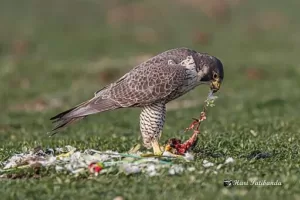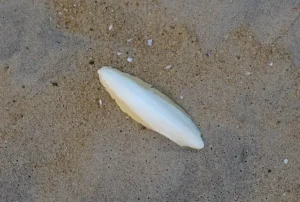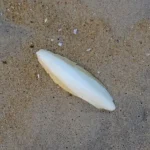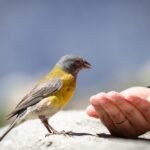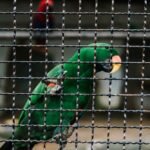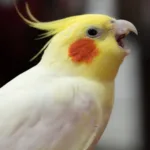The level of predation across all species of parrots varies highly. Some invasive species plague the habitats of certain parrots and hinder their chances of survival. While in other areas predation risks are minimal.
As a way to minimize vulnerability to predator attacks, parrots stay in large groups and are vigilant at all times. Parrots are most vulnerable when gathering around feeding and drinking sites or when their flock sizes grow unusually large.
Different species of parrots are preyed upon by different animals. However, some of the common predators of parrots include birds of prey such as hawks, eagles, falcons, and owls, in addition to toucans, snakes, monkeys, feral cats, brushtail possums, sugar gliders, and rats.
Quick Navigation
Which Types Of Animals Eat Parrots?
Parrots face threats from both aerial and land-based predators, including birds of prey and animals such as reptiles and mammals.
Hawks
Hawks are strict carnivores that eat anything from insects, small mammals, and birds. Geographically, hawks have a broad coverage, inhabiting various regions, which means they are a common predator for parrots worldwide. While they don’t exclusively eat parrots, hawks may consume parrots if the opportunity arises.
According to The Condor, Goshawks, and Red-tailed Hawks are the principal enemies of the thick-billed parrot in Arizona. In addition, Birds SA reports that brown hawks and fork-tailed kites commonly attack flocks of shell parrots, also known as the budgerigar.
Hawks are known for their patience and the signature surprise attack that makes them skilled predators. However, hawks and other birds of prey are not always successful in catching parrots. Parrots are skilled at avoiding predators and know their habitat well.
Researchers from Biodiversity Observations conducted a four-month study to document the predation attempts on the cape parrot. The observations revealed frequent attacks and chasing by raptors such as African Goshawks and Black Sparrowhawks.
No predation event was recorded, however, a few carcasses found on the ground hint at potential predation incidents or death from Psittacine beak and feather disease (PBFD), which is a common disease that plagues the endangered cape parrots.
Eagles
Several eagle species hunt and eat parrots. Their impressive eyesight helps them spot prey from great distances before they begin chasing them.
Eagles, being larger than other birds of prey, are known for hunting animals much larger than themselves. This means that a parrot, regardless of its size, is essentially defenseless against an eagle once it is in its grasp.
Scientific Reports identified 17 species in the Harpie eagle diet in the Atlantic Forest. Sixteen of those species included small mammals and one parrot that belonged to the family Psittacidae.
Another instance of an eagle scanning for parrots to prey on can be seen in the Tambopata Reserve of South-Eastern Peru. The clay lick attracts hundreds of birds, including macaws and other species of parrots and parakeets.
Parrots feed on the clay lick for hours. In the article by Wild Planet Adventures, the author tells us that the arrival of one ornate hawk-eagle prompted the flocks of parrots to disperse. It also shows that when parrots sense danger they respond collectively.
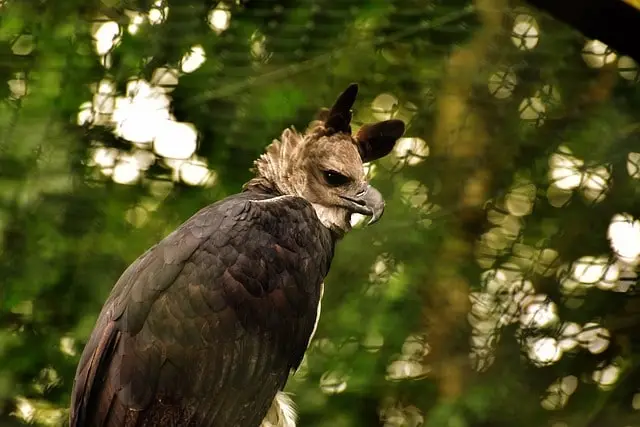
Falcons
Falcons can be called the murdering cousins of parrots because according to recent genetic analyses, falcons are found to be more closely related to parrots than to hawks and eagles.
These birds of prey are some of the fastest and most agile birds of prey that are known for their diving speed that enables them to capture the nimblest of the prey. The Daily Mail reports an incident of a peregrine falcon swooping down and catching a rose-ringed parakeet mid-air in south London.
Toucans
Toucans are mostly frugivores and less frequently seen hunting for sustenance. However, toucans are opportunistic predators that prey upon other birds, including parrots.
Toucan are tropical birds just like parrots. They are native to the Neotropics, which includes Central and South America, and parts of Mexico and Argentina.
Although toucans are not among the chief predators of parrots, they do attack parrots and have even been seen scavenging their bodies.
According to Biological Conservation, The toco toucan is responsible for preying on about 53% of the hyacinth macaw’s eggs.
Bats
Parrots do not face as much threat from the smaller species of bats, also known as microbats, who primarily feed on winged insects, bugs, fruits, and leaves. But the larger species, the megabats are a threat to parrots, especially since they hunt at night.
Megabats like the false vampire bats are found in tropical and subtropical areas and are a top predator of parrots. Parrots also face threats from the big spectral bat, which is a strict carnivore bat species.
Owls
Being nocturnal birds of prey, owls hunt parrot’s nest at night when they are most vulnerable. Parrots do not have good night vision, which puts them in a precarious position.
The barn owl is the most widely spread species of owl, making it a common predator for many parrots. The screech owl and pygmy owl are other owl species that are a threat to parrots.
Pearly Eyed Thrasher
The Pearly-eyed Thrasher is both a nest competitor and predator of parrots. Despite being different species, both birds share similar ecological traits, including habitat preferences and food resources.
This leads to conflicts, particularly in the case of nest site selection. The Pearly-eyed Thrasher, while foraging or searching for nest sites, opportunistically preys on the eggs and chicks of parrots.
Big Cats
Some big cats like ocelots and jaguars may occasionally feed on parrots in the wild, but it mostly depends on the availability of other prey.
Parrots are not a preferred food for most big cats. Big cats prefer to hunt larger prey, such as deer, antelope, and wild boar.
Hunting takes a lot of energy, which is why big cats focus on large land mammals because they provide more meat for them and their family.
However, medium-sized felines such as the bobcat are more interested in hunting parrots. They are a natural predator for the thick-billed parrot.
Snakes
Snakes are one of the main threats to nesting adult parrots. Ornithologists hypothesize that parrots avoid predation by snakes by choosing nesting sites in isolated trees without vines and no canopy contact with neighboring trees.
An article by Cambridge Core provides evidence for this hypothesis. One study revealed that the nests of the Black-billed Parrot, which failed due to chick loss, were characterized by an abundance of vines and an interlocking canopy.
Another study suggests that arboreal snakes have a preference for trees with vine cover and canopies, particularly the Jamaican boa. These snakes show heightened activity during the breeding season of parrots.
Monkeys
Monkeys are omnivorous and typically eat a variety of foods, and sometimes may eat parrots. Capuchin monkeys that live in rainforests have a varied diet, which also includes parrots occasionally. They do not actively seek out parrots and parrot nests, but if the opportunity presents itself they may attack.
Brushtail Possums
Possums are considered to be opportunistic omnivores, consuming fruits, nuts, insects, and animals smaller than their size like rodents. However recent research shows that their diet comprises a lot more meat than it was previously believed.
Brushtail possums are marsupials native to Australia. They are also found in New Zealand as they were imported in large numbers for the fur trade. Brushtail possums have been observed killing various species of parrots in both countries.
According to Australian Geographic, brushtail possums have been recorded killing and eating keas and other parrots native to New Zealand. In Australia, their inclination for meat was revealed when they were caught sneaking into the nests of Glossy Black Cockatoo on Kangaroo Island. To prevent brushtail possums from eating the eggs and chicks of cockatoos, metal collars were put on tree trunks.
Sugar Gliders
Sugar gliders pose a widespread risk of predation of the critically endangered swift parrots in the Tasmanian forests. Sugar gliders are arboreal creatures that nest inside tree hollows, which makes their presence in the woods an ongoing threat to the swift parrots.
However, the level of threat posed by sugar gliders to swift parrot nests is not the same throughout the entire breeding range of swift parrots. In areas where swift parrots breed on offshore islands, there is minimal predation pressure from sugar gliders.
According to the Zoological Society of London, nest failure rates of the swift parrots on the mainland reached 83% while it was 0% on the islands, over three years of monitoring.
A subsequent year data revised the numbers to 78.5% on mainland forests and 2.4 on the islands. Among nests failing due to sugar glider predation, a substantial percentage (64.9%) involved the mortality of swift parrot mothers.
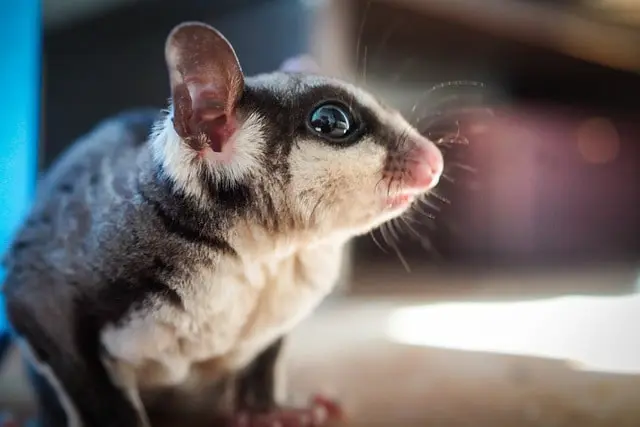
Rats
Depending on the size of the rat, it can pose a danger to parrots. Rats usually attack parrot’s nests to eat their eggs and chicks. However, the risk to the parrots in such encounters is often not very high because rats are at a disadvantage.
In most instances, parrots are able to fend off rats successfully, and the skirmish often leads to the intruders falling from the tree, which severely hurts, if not kills them.
However, not all types of parrots are able to defend against rats. The kakapo, a large flightless parrot suffers from nest predation due to rats. Bird Conservation International suspects Polynesian rats to be the reason for the low reproductive rates of the endangered Kakapo.
How Do Parrots Avoid Predators In The Wild?
Parrots have a number of strategies for avoiding predators in the wild. Here are some of the methods they use:
Large Flocks
Parrots form large flocks, which is an effective strategy to deter predators as it makes it challenging to single out individual birds, reducing the risk for each member.
Alert Calls
Parrots often make loud calls to alert other members of their flock of the presence of a danger. This allows a rapid and synchronized escape from the potential dangers.
In response to intruders, parrots make loud calls and all individuals fly away, abandoning feeding for at least a half hour. The large parrots show the lowest rate of total abandonment while the smaller parakeets show the highest.
Choosing Nest Cavities Inaccessible To Predators
Nest predation is the reason for a substantial percentage of the nest failures. This has made parrots highly selective about the nest cavities they choose. Parrots nest in high and deep cavities, which are hard for snakes and other predators to reach and improve their chances of survival.
FAQs
Do Dogs Eat Parrots?
Wild dogs may eat parrots sometimes, but they often avoid chasing after them. Dogs are land animals so they typically go after small prey like rabbits, rats, wallabies, and bandicoots. Unlike cats, dogs cannot climb trees, which is another reason why an encounter with parrots is uncommon.
Domesticated dogs have the same instincts as their wild counterparts and may leap to attack birds in cages, especially if they are not introduced to each other. Dogs are generally less of a threat to parrots as compared to cats.
Do Cats Eat Parrots?
Cats are a threat to parrots especially when they are not familiar with your parrot. If a cat were to attack a parrot inside a confined space like a room or even a house, the parrot may not be able to fend for itself as it cannot find a place to fly to a height out of the cat’s reach.
Cats kill parrots, as well as other small animals, as an instinct. In the wild, cats hunt small prey like birds and rodents for food and domestic cats may exhibit the same behavior.
Do Humans Eat Parrots?
Parrots are edible but they are not widely consumed by humans. Native Amazonians and some tribes in parts of Africa are known to hunt and eat parrots. However, the consumption of parrot meat is not a widespread practice by humans around the world.
Do Crows Eat Parrots?
Crows typically do not engage in direct conflict with parrots. However, crows are opportunistic feeders, and they may be seen consuming parrot carcasses if encountered on the ground. Crows are opportunistic feeders, and while they may not actively prey on live parrots, they will readily scavenge if the opportunity arises.
